Temples of Bhubaneswar
Bhubaneswar called the 'City of Temples' boasted of more than 7000 temples in the ancient period. It is amazing to find 500 of those temples surviving today.Ashoka defeated Kalinga king after a bloody war but renounced the world and embraced Buddhism. After Ashoka Buddhism declined and Kalinga came under the influence of Jainism.Orissa attained new heights in art, culture trade and commerce under Kharvela.
The Kesari and Ganga Kings were very powerful and ambitious builders who were followers of Shaiva and Vaishnava faith. Magnificent temples of Bhubaneswar, Puri and Konark were constructed during their reign (712-1200 AD). Orissa was annexed by Akbar in 1592 AD when last Hindus ruler of Orissa was over-thrown by a Muslim general .Many temples were destroyed during Muslim invasion. British annexed Orissa in 1803 and declared it a separate province in 1936.
Lingaraja Temple
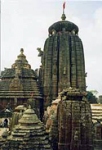 An epitome of the Orissan temple architecture it is one of the most beautiful temples in India. The deity "Tirubhuvaneshwar" meaning "Lord of the three worlds" is Hari-Hara that is half Shiva and half Vishnu. Some parts of this temple are over 1400 years old though the present structure dates back from 1090 to 1104 A.D. The original structure consisted only of mandap and garbhagriha. Nat Mandir and Bhog Mandir were added later. The beautiful sculptures of birds, animals, and floral motifs, human figures in erotic postures and gods and goddesses adorn the exterior of the temple. The lingam is made of uncarved granite which is 8 ft in diameter and raised 8 inches above the ground.
An epitome of the Orissan temple architecture it is one of the most beautiful temples in India. The deity "Tirubhuvaneshwar" meaning "Lord of the three worlds" is Hari-Hara that is half Shiva and half Vishnu. Some parts of this temple are over 1400 years old though the present structure dates back from 1090 to 1104 A.D. The original structure consisted only of mandap and garbhagriha. Nat Mandir and Bhog Mandir were added later. The beautiful sculptures of birds, animals, and floral motifs, human figures in erotic postures and gods and goddesses adorn the exterior of the temple. The lingam is made of uncarved granite which is 8 ft in diameter and raised 8 inches above the ground.
Rajarani Temple
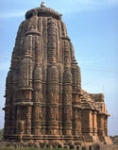 Built in the 11th century AD Rajarani temple stands majestically in a green field. Dedicated to Lord Brahma it was constructed around the 11th century. It has no presiding deity now .There is a beautiful 59 feet high tower in the temple. The temple is famous for its beautiful sculptural art of erotic postures of mithuna couple, nayikas, nymphs, gajasimha and other exquisite stone carvings. The temple got its name because of the red-gold color of the local stone, Rajraniya used for the construction of the temple.
Built in the 11th century AD Rajarani temple stands majestically in a green field. Dedicated to Lord Brahma it was constructed around the 11th century. It has no presiding deity now .There is a beautiful 59 feet high tower in the temple. The temple is famous for its beautiful sculptural art of erotic postures of mithuna couple, nayikas, nymphs, gajasimha and other exquisite stone carvings. The temple got its name because of the red-gold color of the local stone, Rajraniya used for the construction of the temple.
Vaital Deul Temple
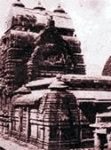 Vaital Deul temple situated near the Bindu Sarovar tank was build during 8th century AD. Devoted to the Goddess Parvati-Chamunda or the Shakti who is portrayed as the slayer of Mahisasura, the buffalo demon. You can scenes of tantric rituals on the niches on the inner wall. The temple has depicted erotic sculptures on the walls and the interiors are embellished but the outer walls are plain.
Vaital Deul temple situated near the Bindu Sarovar tank was build during 8th century AD. Devoted to the Goddess Parvati-Chamunda or the Shakti who is portrayed as the slayer of Mahisasura, the buffalo demon. You can scenes of tantric rituals on the niches on the inner wall. The temple has depicted erotic sculptures on the walls and the interiors are embellished but the outer walls are plain.
Mukteswar temple
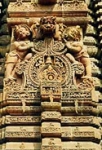 The Mukteswar temple was built around the 10th century AD belonging to later phase of Kalinga School of temple architecture. It has shown tales from Panchatantra with the images of Buddhist, Jaina and Hindu pantheon. Dedicated to Shiva as Mukteshwar, meaning "The Lord who bestows freedom through yoga" the tower of the temple measures 10.5 m. The most exquisite part of the temple is the torana.
The Mukteswar temple was built around the 10th century AD belonging to later phase of Kalinga School of temple architecture. It has shown tales from Panchatantra with the images of Buddhist, Jaina and Hindu pantheon. Dedicated to Shiva as Mukteshwar, meaning "The Lord who bestows freedom through yoga" the tower of the temple measures 10.5 m. The most exquisite part of the temple is the torana.
Parasurameswar Temple
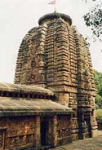 Parasurameswar temple one of the oldest Siva temples is made on the Kalinga School of temple architecture. Built in 650 AD it is dedicated to Lord Shiva. The temple is exquisitely carved with the intricate carvings of elephant and horse processions, human figure, floral motifs and the bust of Shiva. You can see the Shahastra lingam or the 1000 small lingams joined together at the corner of the courtyard.
Parasurameswar temple one of the oldest Siva temples is made on the Kalinga School of temple architecture. Built in 650 AD it is dedicated to Lord Shiva. The temple is exquisitely carved with the intricate carvings of elephant and horse processions, human figure, floral motifs and the bust of Shiva. You can see the Shahastra lingam or the 1000 small lingams joined together at the corner of the courtyard.
Brahmeswar Temple
Brahmeswar temple belongs to the mature Orissan School of Temple Architecture. The deul and the jagmohan of the temple are beautifully carved. The temple depicts musicians and dancers on the outer wall of the temple for the first time. The iron beams are also used for the first time. Chamunda, Shiva and other deities are depicted in the western end of the temple. The temple has a living deity, which is shown through the saffron pennant flying from the top of the temple.
There are several other temples to be visited in Orissa. They are Luxmaneswar, Satrughaneswar and Bharateswar temple, 16th century, Swarna Jaleswar temple, 7th century, Brahmeswar temple, 11th century AD, Bhaskereswar temple and Bharateswar temple etc.
Some of the Major Architecture in Ancient & Medieval Times in India
Contribute More Facts